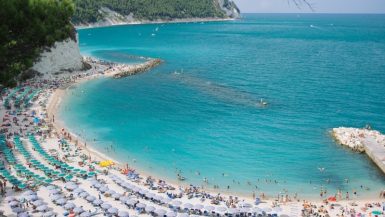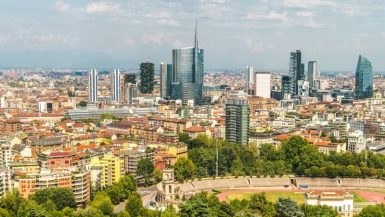
Italy is overflowing with mesmerizing destinations from the Alpine north to the sun-soaked south. Deciding to vacation on the peninsula that bought us pizza and pasta is easy, but choosing between Sardinia or the Amalfi Coast is a little harder.
Sardinia is the second-largest island in the Mediterranean with nearly 2,000 km of coastline and rugged hinterlands made up of rocky mountains and nature reserves. Sardinia is best known for its turquoise seas and ancient history. Likewise, Amalfi is a sprawling section of the coast on the Sorrentine Peninsula in Southern Italy with rocky cliffs, sparkling seas, and upscale appeal.
Sardinia and the Amalfi Coast are very different but both offer sumptuous Italian cuisine, bustling Mediterranean beaches, and great weather. If you’re wondering which destination will better suit your travel style, check out our side-by-side comparison of the two below. Let’s go.
Sardinia or The Amalfi Coast: The General Vibe

Sardinia is a large island off the west coast of the Italian peninsula. It’s nestled between French Corsica and the island of Sicily and is second only to the latter when it comes to the biggest islands in the Med. That said, Sardinia is even further separated from Italian culture than vast Sicily, with its own language, prehistoric heritage, and rugged landscape.
In contrast, Amalfi is the epitome of the dolce vita. This 50 km stretch of coast in the Calabria region of southern Italy is picture-perfect—and one of the most photographed places in the country at that. A few villages punctuate its shores where sheer cliffs tower above the Tyrrhenian Sea. The Amalfi Coast is best known for its colorful fisherman houses, lavish sea view terraces, grand mansions, and fragrant lemon groves.
Sardinia is a much more rustic and authentic destination, but Amalfi is quintessentially Italian. The natural beauty of Sardinia is undeniable and it is much more understated and untrodden than the Amalfi Coast, but this shouldn’t come as too much of a surprise in view of its considerable size compared to a small strip of the Sorrentine Peninsula.
Nevertheless, Amalfi is unavoidably touristic and much more so than other coastlines in Calabria. Sardinia promises more variety and a holiday you can tailor to your wishes, while Amalfi is never-changing with its old-school Italian elegance.
Winner: Sardinia
Sardinia or The Amalfi Coast: The Ease of Travel

One might assume that thanks to Sardinia’s outlying location off Italy’s west coast it would be harder to get to, but this isn’t necessarily the case. Taking the ferry from Italy to Sardinia is long and expensive with the quickest crossing taking five hours and it isn’t a route frequented by tourists. However, flying is relatively hassle-free and there are three airports to choose from when landing in Sardinia.
Most flights from the UK and the rest of Europe will involve connections, with stop-offs in Rome being most common, but Rome is just one hour by air from Sardinia and you could get from London to Sardinia in just four hours total. Sardinia is a big island with an efficient train and bus system to help you get around. Services run between the airports and all the main resort towns, but hiring a car is relatively cheap and the road networks are advanced.
Located on the Italian mainland, you can get to Amalfi without requiring a connecting flight from many European cities. Naples Capodichino Airport is the closest international airport to the Amalfi Coast, located around 60 kilometers from the southeast coast of the Sorrentine peninsula. However, many people choose to fly into Rome to get to Amalfi, since it can be cheaper, before getting on a connecting flight or train to Naples. This means it could take you the same amount of time to get to Amalfi as it takes to reach Sardinia.
What’s more, Amalfi is located on the other side of a hilly peninsula from Naples with winding coastal roads that can take almost two hours to travel by bus while taxis are notoriously expensive. You have the option of taking the train to Sorrento, but you’ll still need onward travel to cover the further 30 kilometers.
However, one of the best ways to reach Amalfi’s hilltop towns is via ferry. This route takes around an hour and a half, but the scenic view from the boat of the cliff face and all the villages on the Sorrentine Peninsula is worth the haul.
Amalfi is also much better connected to the rest of Italy than Sardinia and easier to visit if you’re interrailing or road-tripping around the country with a selection of destinations to tick off. Once you’re in Sardinia, you’re isolated to spending the rest of your time on the island, unless you want to hop on a flight back to the mainland.
The closest island to Sardinia is Corsica, another dreamy holiday destination with upscale resorts and white sand beaches. The distance between northern Sardinia to the southern point of Corsica is just 12 km, but the ferry can still take a few hours depending on your port of departure and arrival. Since the island is owned by France, you’ll also need to cross a maritime border and show your passport when you arrive if you’re not an EU citizen.
Winner: Draw
Sardinia or The Amalfi Coast: The Beaches

If it’s beaches you’re after, Sardinia is the undoubted winter. The island has close to 2,000 km of shoreline compared to Amalfii’s measly 50 km, which is mostly cliffs anyway. You’ll struggle to find somewhere to say in Amalfi that’s right on the beach, with most villages being set back on a hillside, while Sardinia is scattered with beachside resorts from the celebrity-loved beach clubs of Costa Smeralda, to the family-friend sands of Cagliari.
It might be known for its panoramic sea views and cliff-jumping opportunities, but Amalfi isn’t a premier beach destination. Even Positano, the iconic seafront town with its own rocky beach, isn’t ideal for sea lovers or young kids. That’s because the pebbly shores are uncomfortable underfoot and using the beach can be expensive if you want a sun lounger—which you will need.
If you’re traveling with children, Sardinia is much more exciting in general. It’s overflowing with mesmerizing white sand beaches, lapped by crystal clear waters that are perfect for swimming, snorkeling, and water sports. Amalfi is famous for its boat trips, but these are expensive and beach fun isn’t at the top of the agenda. Although, with Capri nearby, taking to the seas for a cruise through the lover’s arch is undeniably romantic and perfectly suited to couples.
Not only does Sardinia have its fair share of inviting sands and luxurious resorts, but it’s also one of Italy’s best, and only, surfing destinations. The island is exposed to all swells and you can jump on a board at most times of the year. The west coast is a magnet for high waves. Check out Silver Rock Reef for fast rights that reach twelve feet and barrelling lefts.
Winner: Sardinia
Sardinia or The Amalfi Coast: The History

Italy was the seat of one of the most influential civilizations of all time, so it’s no surprise that you can soak up its thousands of years of ancient history at every corner of the country. Sardinia might not be the first place you think of in terms of Italian heritage, but there’s evidence to believe that it was one of the first inhabited places in the country and its unique archaeology dates back thousands of years.
Prehistoric tribes left the Giants’ Grave and Domus de Janas that now form part of a Bronze Age archaeological complex in the far northeast of the island. They’re thought to have been built by the Nuragic people who lived in Sardinia from the 20th century BC to around 200 BC when the Romans colonized the island.
The most prominent sign of their existence is the more than 7,000 megalithic marvels that the Nuragic people left on the island. Known as nuraghi, these large monuments were thought to have been defensive structures and resembled stone beehives with their cone shapes and corbel-arched chambers.
The Nuragic people not only left some of the most fascinating and antiquated relics of the ancient world on Sardinia, but the perseverance of the tribespeople is a symbol of the constant of Sardinian resistance.
The Phoenicians and the Punics also left their mark on Sardinia in the way of charming cities like Nora and Tharros, while the Romans improved roads and built their own towns. The Cagliari Archeological Museum is a great place to visit for an insight into Sardinia’s past and the lives of its former inhabitants.
The Amalfi Coast might seem to be more about Instagram-worth views and yacht-studded harbors than ancient sites, but many of its towns have rich historical legacies of their own. For example, the town of Amalfi was the capital of the Duchy of Amalfi, a maritime republic and important Mediterranean trading power between the 9th and 13th centuries.
The founding of Amalfi goes back to a legend from Homer’s Odyssey that says Odysseus, a Greek mythological hero, and king of the island Ithaka, was sailing near the Sorrentine Peninsula and heard a song of the sirens that he couldn’t resist. In the legend, Odysseus orders his men to plug their ears and tie him to the mast of his ship to restrain him from temptation.
This made him the first to resist the sirens’ song. However, the Gods of Olympus underestimated his ingenuity and flew down to save Odysseus from a shipwreck. Instead of landing on his boat, they’re said to have landed on the pristine Sorrentine Coast, churning up the rocks with the force of their landing to create the rugged cliffs of the Amalfi Coast.
Due to Mount Vesuvius’ eruption in 79 AD, real historical evidence is harder to reconstruct about the origins of Amalfi. Nonetheless, in the small town of Minori, in the middle of the coast, you’ll still find the remnants of an ancient Villa Romana, build in the 1st century, which suggests that the sleepy village was the first inhabited commune of the region.
When it comes to exploring history, both medieval and more recent, the Amalfi Coast has more important landmarks than you might expect. The Duomo di Amalfi, in the eponymous town, is a medieval cathedral with an ornate facade that was restored in the 1800s, while Positano has its own historical church, the Chiesa di Santa Maria Assunta complete with a Byzantine Madonna.
There’s also Villa Rufolo in hilltop Ravello. The property dates back to the 13th century and is built in an Arab style with spectacular gardens and sea views. And don’t miss Museo della Carta for an insight into the rich history of papermaking in Amalfi.
Winner: Draw
Sardinia or The Amalfi Coast: The Food

Italy is known for its influential gastronomy and both Sardinia and the Amalfi Coast balance their own distinct cuisine with Italian traditions. Sardinia, all-surrounded by the Mediterranean, and Amalfi, with its sun-soaked coastline, are hotspots for seafood lovers. Fish is a staple in the Sardinian and Sorrentine diets, but while Amalfi is known for its shrimp, grilled octopus, and sea bream, Sardinia is prized for its lobster, tuna, and bottarga.
Where Sardinia also differs from the Amalfi Coast in that the cuisine can be divided into land and sea, with different specialties hailing from different parts of the island. “Su porcheddu” is one of the national dishes. This spit-roast suckling pig is served on special occasions and as a Sunday meal in Sardinian homes.
“Malloreddus alla campidanese” is another dish from the rural inland. The gnocchi-like pasta is colored with saffron and is usually cooked with ground pork and tomato sauce. “Culurgionese” are loved by Sardinians too. These stuffed pasta parcels look more like dumplings than ravioli and are filled with mashed potatoes, pecorino, and mint.
Sardinian cuisine can be much more rustic and hearty than Amalfi’s light seafood affair, but that doesn’t mean that the “Divine Coast” is lacking in variety. Campania is home to one of Italy’s most envied culinary landscapes after all and Amalfi is just an hour away from the modern birthplace of pizza. How can Sardinia possibly compete?
Campania brings us buffalo mozzarella, San Marzano tomatoes, green Ravello olives, and the best olive oil you’ve ever tasted. The Amalfi Coast lemons are also unusually large and produce 25 percent of their volume in juice. Their recognizable fragrance wafts over the coastal roads from terraced lemon groves. Amalfi lemons are used to make gallons of limoncello, the after-dinner liquor that is shipped all over the world and loved by many.
Moreover, the muscles, prawns, urchins, and squid with which Amalfi’s seas are teeming are the main components for many unforgettable recipes like “scialetelli ai frutti di mare” (seafood fresh pasta), “il fritto misto” (mixed fried platter), and “risotto alla pescatora” (seafood risotto). The Amalfi Coast is known for some of the world’s finest seafood and iconic exports.
Winner: The Amalfi Coast
Sardinia or The Amalfi Coast: The Costs

Both the Amalfi Coast and Sardinia can vary quite a lot in cost, depending on where you go. Sardinia is a huge island and generally much cheaper than Italy’s glamorous mainland resorts, but some of the paradisical beaches have become popular with celebrities over the years, and the yacht-studded harbors of Costa Smeralda, for example, can even be more expensive than the Sorrrentine Peninsula.
In contrast, the Amalfi Coast is notoriously upscale. It’s known for its unaffordable accommodation, private beaches, and restaurants where you pay more for the view than the food. But there are some small towns where lodgings can cost half of what they do in places like Positano and hidden trattorias where you can find cheap local food if you’re willing to sacrifice views for rustic, family vibes.
That said, Amalfi is the more expensive option in general and Sardinia is much easier to visit on a budget, with so many untrodden villages and laidback cities to choose from. On average, you can get by on €96 a day in Cagliari, Sardinia’s capital, whereas you’ll need closer to €160 to sustain the same holiday in Amalfi.
Hostel and single-occupancy accommodation start at €50 a night in Sardinia, with the average double-occupancy room costing around €105 a night. On the other hand, you’ll need around €80 to stay in a hostel dorm for one night on the Amalfi Coast and €160, on average, for a double-occupancy room, which can be more than double in towns like Positano.
Local transport shouldn’t cost more than €24 if you’re traveling between Sardinia’s cities and beaches, but you’ll need €50 a day in Amalfi to venture to places like Sorrento, Pompeii, and Naples. Better yet, you could get by on just €30 a day for food in Sardinia, but you’ll need around €50 or more per person on the Amalfi Coast just to eat.
If budgeting is your priority, it’s a no-brainer. Sardinia is much more economical than the Amalfi Coast.
Winner: Sardinia
Sardinia or The Amalfi Coast? The Verdict
Sardinia is huge in comparison to the Amalfi Coast and much more underrated. There are a lot more locations to choose between on the island, whether you’re after a beachfront resort or rustic mountain retreat, and arguably, there’s something for everyone. In contrast, the Amalfi Coast sells one type of vacation. There is some variety between the guest houses in Minori and the five-star hotels in Positano, but jagged shores, busy beaches, and high prices are synonymous with the whole region. Ultimately, the Amalfi Coast is more romantic and iconic, while Sardinia is more dynamic and family-friendly. Which one gets your vote?


